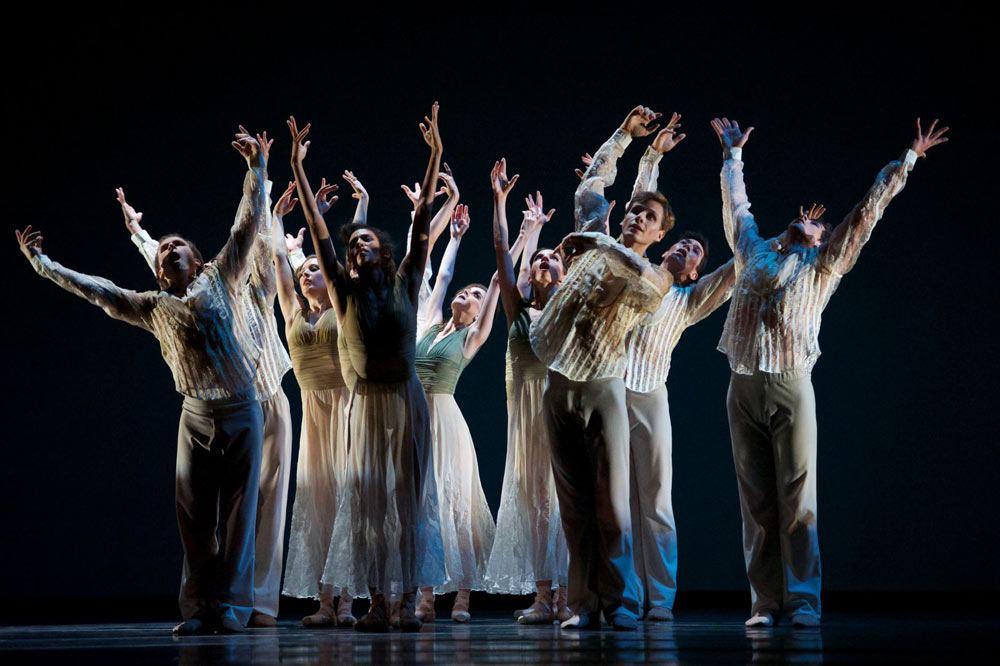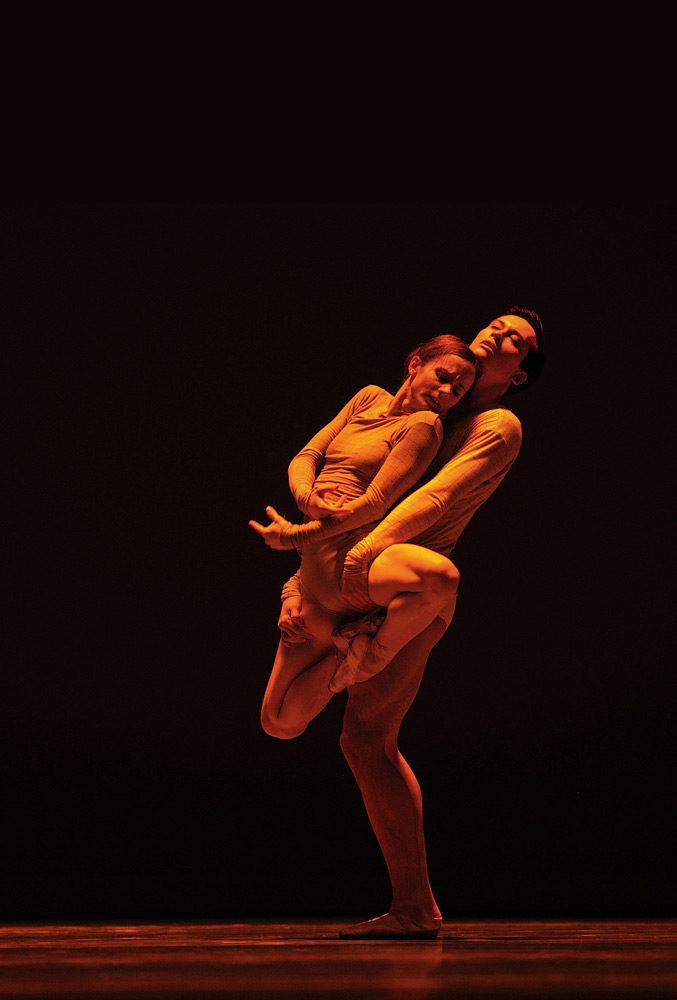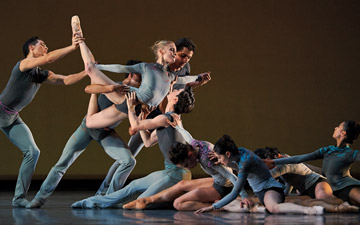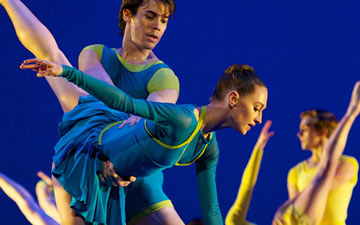
© Erik Tomasson. (Click image for larger version)
San Francisco Ballet
Trio, Ghosts, and Borderlands
New York, Koch Theater
16 October 2013
www.sfballet.org
davidhkochtheater.com
Go West
San Francisco Ballet is in town for two weeks, and on the evidence of opening night, this should be an invigorating visit. The company looks to be in top form. Throughout the evening, the dancers moved with real power and drive, plunging into the steps, taking no prisoners. The company style seems to combine the speed and attack of City Ballet with the three-dimensionality and grandeur of American Ballet. On this night several dancers stood out – including Vanessa Zahorian, Sarah Van Patten, and Sofiane Sylve – but in reality it was the company as a whole that made an impression. It really looks like a company.

© Erik Tomasson. (Click image for larger version)
In this first week, the troupe will perform four mixed bills. With the exception of Serge Lifar’s Suite en Blanc, all the ballets are of recent vintage, and new to New York. (Next week, the company will unveil Christopher Wheeldon’s lavish new Cinderella.) The programs are a real cornucopia, and the catalog of choreographers no less impressive, led by a starry quartet: Mark Morris (Beaux), Wheeldon (Ghosts), Alexei Ratmansky (From Foreign Lands), and Wayne McGregor, whose Borderlands – a symphony of contorted bodies bathed in cool lighting – seemed to be the hit of the opening-night program.
In a way the company is making up for lost time. They haven’t been here since 2008, before the financial meltdown. But such tours have an immeasurable effect; they broaden the dancers’ horizons and shake up the locals. Last night, the Koch Theatre was full of dancers, members of various home companies, taking advantage of a $25 ticket scheme (excellent idea). I’m sure that what they saw will influence and feed their own dancing for a long time.

© Erik Tomasson. (Click image for larger version)
The audience last night was also treated to some excellent playing by the New York City Ballet orchestra, led by Martin West, San Francisco’s music director and principal conductor. It’s not often we get to hear Tchaikovsky played in this house with such sweep and sense of drama. No wonder Helgi Tomasson’s Trio – the opening ballet – got off to such a thrilling start. Tchaikovsky’s String Sextet in D minor (known as “Souvenir de Florence”) is one of the composer’s ultra-Russian works – with echoes of his Serenade for Strings in C and cascades of Russian melodies and dances. (The set, a golden-hued wall by Alexander V. Nichols, helps to sustain this lush, romantic mood.) As the music begins, with its driving triple meter and churning bass, the couples, in red flowing evening wear, fly across the stage. Each section is led by a different couple. Vanessa Zahorian and Victor Luiz were the whirling, flamboyant first pair with the other couples, asymmetrically arrayed, as a kind of chorus. The second movement is an intriguing pas de trois, danced here by Sarah Van Patten, a woman torn between two lovers: Tiit Helimets (noble and steadfast) and Anthony Spaulding, sensual, with an edge of danger. The push and pull within the trio had real weight, but – equally important – avoided histrionics; Van Patten was convincingly torn, but never victimized. The whole scene was suffused with a sense of regret, even guilt. In the end, she left with her suitor, who pulled her backward into he wings, covering her eyes with his hand. Thus do we sometimes give in to impulses that are not altogether good for us.

© Erik Tomasson. (Click image for larger version)
Maria Kochetkova and Gennadi Nedvigin dominated the final movements, which were filled with Russian flourishes – a hand behind the head, a tap of the toe and heel (à la Other Dances). Both danced with great clarity – Tomasson has given Nedvigin a real obstacle course of jumps and turns – but there is a hardness to Kochetkova that makes her hard to love. She stares at the audience insistently, with a strong cast to her jaw. Her movements have a similar edge, and her transitions can be inelegant. If she let herself go a bit, she would be twice as pleasing to watch.
Ghosts, by Wheeldon, is, in my opinion, his best effort since Estancia!, from 2010. It is complex, unerringly elegant, and consistently intriguing in its details. Wheeldon has unleashed his deep reserves of imagination, creating calligraphic movements for the dancers’ arms and hands. Their whole bodies respond to every movement. There is nothing particularly ghostly about the ballet; to my eye, the dancers looked more like water spirits, swimming, rolling, drifting in the currents. The costumes – flowing dresses the color of sea-foam, by Mark Zapone – augment this impression. In a recurring motif, the men crawl under the women, and the women roll over them, bodies heaved by the tide. The constant flow across the stage in elegant arcs and sinuous lines is masterfully handled, as natural as the seasons. The music, by Kip Winger, dominated by solo violin and piano, is veined with mystery: trills, descending melodic lines. In the second, more expansive movement, the dancers enact a kind of ritual, the moon glowing behind them, raising and lowering their arms almost desperately, as if conjuring a spirit.

© Erik Tomasson. (Click image for larger version)
Then comes the all-important pas de deux, for Yuan Yuan Tan and Damian Smith, filled with inventive and swooning lifts – Wheeldon’s specialty – including an odd one in which Smith raises Tan by her ankles. Her feet are flat, as if she were still standing on the floor. Later he partners her with his hands resting on her temples, a move reminiscent of the famous pas de deux in Frederick Ashton’s Sylvia. If anything, the pas de deux is a bit too inventive; a slight case of overkill. Then, another trio, this time for Sofiane Sylve, Helimets, and Shane Wuerthner. Sylve, who decamped from New York City Ballet in 2007, was always an imposing dancer, but now she has become something more, almost monumental. With her ample back, long, sculptural arms, and powerful technique, she dominates the stage and everyone on it. It’s no wonder it takes two men to partner her. In the ballet’s final image, she swoops into the darkness, more goddess than a ghost, as the others drag themselves like caterpillars across the stage. Souls in purgatory? Who knows. Ghosts is a little hard to follow–the imagery isn’t terribly coherent – but it’s an extremely pleasing, skillfully constructed work, full of secrets.

© Erik Tomasson. (Click image for larger version)
Which is more than one can say of Wayne McGregor’s Borderlands. I have yet to understand the attraction of McGregor’s works, in which the extreme contortion of the dancers’ bodies seems to be the primary intention. How far can they go? Very very far indeed. Here, wearing beige briefs and long-sleeved shirts, they undulate and slide, twist and grapple, pulling their limbs asunder. Every articulation is explored, as is every possible conjoining of two bodies. The fingers are splayed or held like claws. McGregor seems obsessed with the dancers’ butts and ribcages, both of which are prominently displayed. There is a certain fascination to watching bodies being contorted in awkward, self-consciously ugly, wide-open poses, but, at least for me, the fascination passes quickly, leaving a kind of glazed shellshock. What is his point–that dancers are freaks of nature? That they can do anything?
McGregor has said that Borderlands was inspired by Josef Albers’ abstract paintings, in which various intense colors interact, creating a kind of extreme visual stimulation. The designs of Borderlands, by McGregor and Lucy Carter, are the best element. The stage is turned into a white box, suffused with hazy, colored, flickering lights. A dark square rises up, later replaced by another square, outlined in light. Within this high-tech landscape of colored light, the dancers move like colorless particles. McGregor has said that he finds Albers’ paintings to have a “dirty…not quite resolved…dysfunctional” quality, a kind of “extreme sensuality” which he has attempted to replicate in the movement. This helps to explain some of the partnering, especially a pas de deux for Maria Kochetkova in which her partner, Lonnie Weeks, seems intent on prying her apart. She flops on the floor, he pulls her up, limp; we hear the slapping of flesh on flesh. He swings her around with one leg uncomfortably bent, drags her across the stage in a split with her foot over his shoulder and her arms limp, and finally picks her up by her thighs, pulling at her legs as if to split her groin wide open, as she stares out at the audience. It’s not so much dirty as it is gynecological.

© Erik Tomasson. (Click image for larger version)
If this weren’t bad enough, the choreography is aimless, relentlessly frontal, and rhythmically uninteresting. The music, by Joel Cadbury and Paul Stoney, is blandly electronic, even, at times, sentimental, in space-odyssey kind of way. That said, there are a few arresting moments. McGregor does have a rich imagination, overflowing with ideas, and some of them work. I was very struck by a section for the men in which their hands pulsated at very high velocity, like vibrations of sound, while they moved through a sequence of highly formal steps. It was also curious to see the juxtaposition of women on pointe and those in soft slippers, side by side. In a second pas de deux, Sofiane Sylve – emphatically on pointe – was able to impose a kind of glamor and dominatrix allure on the steps, turning them into a statement about physical prowess and power. I can understand (but don’t share) the enthusiasm for the extremes to which the dancers are able to push their bodies, and I can see why dancers might enjoy being pushed in this way. But what, really, do such works leave us with? Where do we go from here?

















[…] And here’s my review of the first night. […]
Correction: The company’s last visit to NY was in 2008, not 2006. My apologies.
Duh – poor subbing by me – the date change and choreographer typo are corrected.
Hi Marina-
In the paragraph beginning with “Maria Kochetkova and Gennadi Nedvigin dominated the final movements…”, you also say, “Helimets has given Nedvigin a real obstacle course of jumps and turns”. I believe you mean to say that Helgi Tomasson, SFB’s AD and choreographer of the ballet ‘Trio’, has given Nedvigin those jumps and turns…*not* Principal Dancer Tiit Helimets.
Fabulous review of our beloved SFB, otherwise! Thank you!
Teri McCollum
Odette’s Ordeal
I feel inclined to respond about McGregor’s work, not necessarily to defend it but particularly to steer the surrounding dialogues in a more positive direction.
I’m a trained dancer. I’ve been practicing Ballet since I can remember, and as far as I’m concerned the whole nature of technical training is pretty contorted from the get go. It’s the very nature of most traditional dance to render contortions of the body in one way or another because that’s what we can call anything that isn’t resting or functional action.
Of course, bodies at rest (the universe of pedestrian gesture inclusive) are beautiful, but the point of dance training has generally been to access other capacities. Really, at its ultimate, to dance is to make *all* of the shapes. To manifest every possible energy. To be as total as the environment in which the body thrives.
With that perspective in mind, and despite having not seen this particular concert, I would say simply that we must be careful not to miss what is right in front of us. McGregor may or may not be trying to broaden the lexicon of movement and fundamentally expand the potential of human expression, but to me that’s the tune he’s playing. That dancers are able to master his choreography is no more remarkable or significant than that they are able to manifest anyone else’s movement concepts. McGregor asks it of them because his pallet exceeds “traditional” parameters for the body’s functions.
What I mean to say is this:
Because McGregor’s work can seem so “un”-human, I think we need to broaden the definition of “human” instead of narrowing the definition of “dance.”
Thank you – Terrific points. McGregor’s work rather polarises opinion, some affronted, some the converse. For myself I see it as different movement and I applaud that difference – if probably more in shorter than longer doses! I think though that as McGregor is more exposed to ballet his style does seem to be softening a little and becoming less alien. But somehow I don’t see him doing a full evening Pride and Prejudice!
For those wanting a wider handle on Wayne McGregor do see Paul Arrowsmith’s recent piece on the exhibition and seminar about the way he works:
Wayne McGregor – Thinking with the Body exhibition & EChO Seminar – London
Dear Teri, Thanks for the catch. Yes, of course, I meant Tomasson, not Helimets.
Dear Henry, McGregor may intend to widen the spectrum of what we see as human, as you say. But after all, he doesn’t work in a vacuum. We see images of the extremes of humanity all the time (war, violence, sexual violence). What eludes me, having now seen 4-5 of his works, is a sense that McGregor connects the images that he creates via the dancers’ bodies to something that recognizes and uses those extremes to say something more profound or complicated or subtle. (Though I’ve heard him speak, and he is full of ideas.) But in the dances, the distortions feel blithely unmotivated and disconnected from each other– extremes for the purpose of being extreme. Strung together without much structural interest and then bathed over with electronica and cool visuals. So I guess what I’m saying is that we’ll have to agree to disagree on this one.
Cheers, M
For as much as I might defend McGregor’s right to work at physical extremes, it isn’t necessarily my cup of tea either. In fact, my own artistic sensibility is to do just the opposite — to eschew the impressive and connect every reality of action to another. I’m glad for diversity and I think the process of criticism is an important part of it. Thanks for the response!